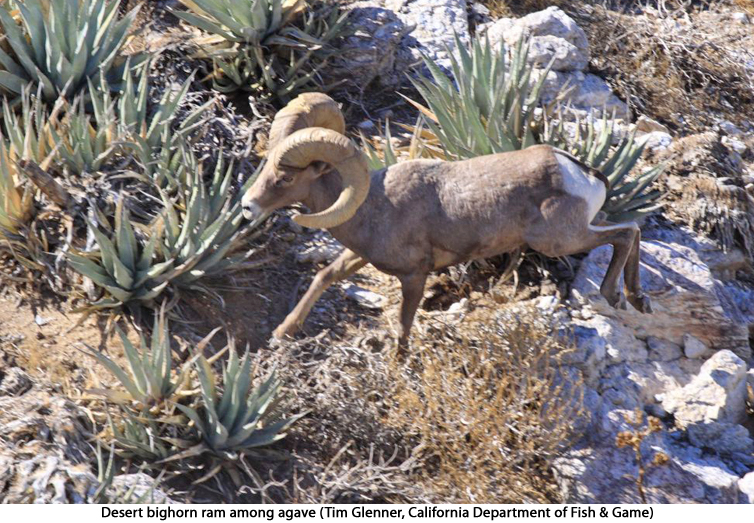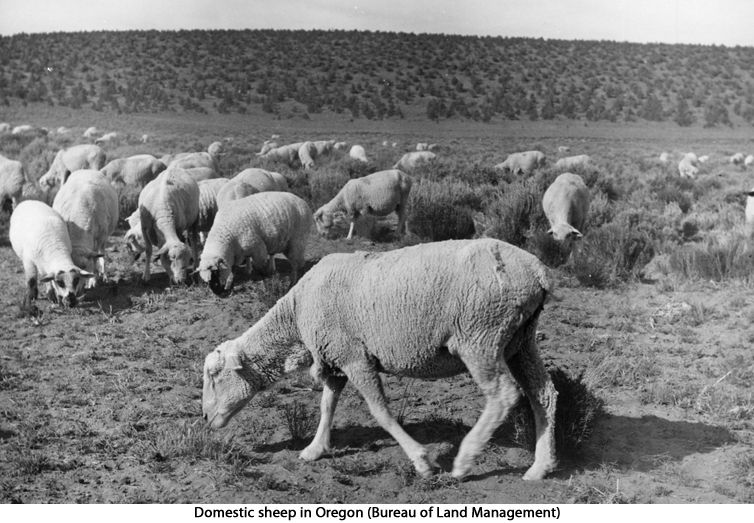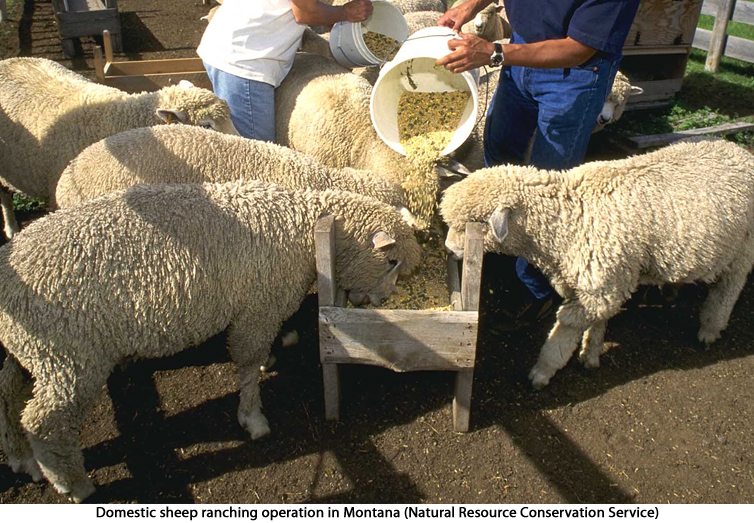INTRODUCTION
Wildlife agencies and land managers did not seem to widely recognize the threat domestic sheep pose to bighorns until about the late 1980s. Dynamic and conflicting scientific paradigms led to such recognition. However, according to the U.S. Forest Service, some official recognition existed prior to the late 1980s:
“Goodson (1982) listed several examples of past management direction or guidelines taken to reduce the risk of disease transmission from domestic sheep to bighorns. As early as 1954, [the] Colorado Division of Wildlife purchased land in bighorn range at Pikes Peak to prevent domestic sheep grazing, thus reducing potential contact between domestic sheep and bighorns. Goodson (1982) noted that the San Bernardino and Angeles National Forests in California developed a policy against domestic sheep grazing on occupied bighorn range as early as 1967. Goodson (1982) also cited NEPA decisions on the Inyo and San Bernardino National Forests to not convert from cattle to sheep allotments based on concern about the potential for disease transmission between domestic sheep and bighorns. As a result of concern over disease transmission between domestic sheep and bighorn sheep, the Director of Wildlife and Fisheries for the U.S. Forest Service sent a memo to Regional Foresters in western regions in 1981 stating that ‘. . . Appropriate caution should be exercised to prevent contact between the species’ (Jones 1981 as cited in Goodson 1982)” (USFS 2006, 4).

Once the disease threat was well-recognized, management agencies adopted and began implementing various policies to ensure the separation of wild and domestic sheep. Some states have been more successful than others.Separation policies are not a catch-all solution. George et al. remark that:
“. . . livestock grazing policies on some public lands in the western United States have been modified to prevent contact between bighorn and domestic sheep in an attempt to reduce the frequency and severity of these epidemics via introduction of novel pathogenic Pasteurella spp. and Mannheimia spp. strains and other respiratory pathogens. Such segregation is not likely to prevent all pasteurellosis epidemics in bighorns, but should help reduce both the frequency and, in many cases, the severity of epidemics in free-ranging populations” (2008, 400).
RECOGNITION OF DOMESTIC SHEEP DISEASE THREAT
Evolving/Conflicting Causal Theories
For context on bighorn-domestic sheep interaction policies, it is helpful to analyze the history of such policies and how wildlife managers’ understanding of wild sheep disease has evolved. In an informal essay presented at the Northern Wild Sheep and Goat Council’s 2002 symposium, wild sheep biologist Wayne Heimer provides a summary:
“The presence of pneumonia die-offs in bighorn sheep prior to European settlement of North America is unknown. With European settlement of the American West, pneumonia die-offs became the dominant factor in management and restoration of Rocky Mountain and California bighorn sheep. Early work suggested lungworm parasites were the causal factor, and the ‘lungworm-pneumonia complex’ was taught as causative in wildlife and ecology curricula for decades . . . . Presuming parasites were causal, antihelminthic drugs were seen as the treatment. The drugs purged bighorns of parasites in laboratory conditions, but pneumonia die-offs persisted in the wild. Eventually, enough die-offs were statistically and pathologically associated with domestic sheep presence that domestic sheep replaced the ‘lungworm-pneumonia complex’ as the causal factor. Managers then generally presumed that bighorn pneumonia die-offs would end if domestic sheep were excluded from bighorn ranges. Still, bighorn pneumonia die-offs were reported in bighorn populations with no documented exposure to domestics. This finding caused some tension between the ‘domestic-caused’ [or ‘germ theory’] . . . and ‘stress-caused’ . . . camps of pneumonia die-off researchers” (2002, 154).

Researchers believing bacteria were the main causal factor in bighorn pneumonia have mainly been located in the Pacific Northwest (Heimer 2002). Scientists placing more emphasis on stress (brought on by parasites or other factors) as a causal factor have generally been further east—“primarily in Colorado and Wyoming, the region where the work on the lungworm/ pneumonia complex dominated research for almost 40 years” (Heimer 2002, 158). The germ theory camp of the bighorn disease issue was dominant in 2002 (Heimer 2002). Heimer illustrates why:
“The ‘stress camp’ points to its more inferential studies of stressors interpreted to cause compromised immunocompetence as well as the fact that some bighorn populations in their region have coexisted with domestic sheep for decades. Still, the ‘germ theory’ school maintains the upper hand . . . . Gathering supportive data for the germ theory remains direct (either the bighorns die or they don’t); ‘stress research’ is more difficult and inferential” (2002, 159).
Politically-fueled tension has existed between the germ theory and stress research camps because the germ theory camp has believed that “domestic sheep must be excluded from bighorn ranges” (Heimer 2002, 159). The stress camp has been less supportive of separation and has wanted to place more emphasis on disease-related factors other than domestic sheep (Heimer 2002). Heimer explains that disagreement over bighorn-domestic separation is controversial “because of the former economic, and remaining cultural importance of the domestic sheep industry in the American West” (2002, 159). Heimer goes on to remark that:
“The domestic sheep industry, fighting for its existence because of its inability to compete on the world domestic sheep products market, is looking for all the help it can get. Typically, the industry opposes any limitations on its ability to compete in a difficult economic situation. As a result, the industry seizes on this divergence of scientific perspective with the argument that the scientists don’t seem . . . to agree, so their interest, domestic sheep, should not be considered harmful to bighorns.
. . . The political power of the domestic sheep industry in the ‘germ’ and ‘stress’ regions is variable, and the differences over the necessity of eliminating domestic grazing (the radical quarantine) lead the ‘germ’ folks to consider the ‘stress’ folks less as colleagues with a differing approach, and more as ‘domestic sheep sellouts’” (2002, 159).

Heimer ends his analysis by stating: “My recommendation for wildlife biologists would be to leave the bacterial adventures and vaccine development to specialists in those fields, and to concentrate on doing the best we can to humanely separate bighorns from domestics. It’s not sexy, and it’s not new; but it will probably do more for bighorns than the excursions into DNA, diseases, and parasites that have occupied us for the last 50 years” (2002, 164).
Necessity of Bighorn-Domestic Sheep Separation
Most management policies regarding wild-domestic sheep interaction focus on preventing it (WAFWA 2010a). The necessity of bighorn-domestic sheep separation has been well-established. Mack states: “It is widely accepted among wildlife researchers and managers that bighorn sheep . . . and domestic sheep are incompatible on sympatric range and must be spatially or temporally separated to prevent disease transmission and catastrophic population-wide bighorn sheep die-offs” (2008, 211). According to Dubay et al.: “Bighorn sheep managers across jurisdictions consider the prevention of pasteurellosis in bighorn sheep to be a management priority and believe that the primary way to accomplish this is to ensure the separation of wild and domestic sheep” (2002, 145). Wehausen, Kelley, and Ramey II argue that “the potential effect on bighorn sheep of contact with domestic sheep appears remarkably clear cut. Where the health of any bighorn sheep populations is valued, the recommendation has been management actions that prevent contact with domestic sheep” (2011, 18).
Among bighorn managers, recognition of the domestic sheep disease threat did not seem to become widely clear until about the late 1980s. Biologists analyzed the bighorn-domestic sheep separation issue during a discussion at the Northern Wild Sheep and Goat Council’s 1999 symposium (Hurley et al. 1999). During the discussion, Schommer stated that: “If you look at the 1970s, we, as a group, put reintroduced bighorn sheep in a lot of areas right on top of domestic sheep. In general, the problem was most of us didn’t have a clue what we were doing” (Hurley et al. 1999, 287). Schommer elaborated on how the problem got recognized and how disbelief persisted well into the 1990s:
“In the 1980s, Nike Goodson came out with a paper that she was beat up pretty good on, concerning the incompatibility between the two species. A lot of people challenged her and it proved out through the 1980s that she was right. I spent a tremendous amount of my personal career trying to get the acknowledgement of the disease problem to people all over the West. It’s not just this group that needs to be educated. There’s still a lot of people that are in denial, mainly the [grazing] permittees and a lot of the land managers that I have to deal with. That was really elevated in the early 1990s by . . . DNA fingerprinting . . . . I think we’ve got most of the people convinced that it’s a problem and we need to keep wild and domestic sheep separated. That’s been a huge undertaking especially with our land managers” (Hurley et al.1999, 288).

In 1989, the disease threat was known well enough for the BLM to ask the Desert Bighorn Council to develop guidelines for domestic sheep management in bighorn habitat (Brigham, Rominger, and Espinosa T. 2007). By 2008, bighorn-domestic sheep interaction was a management concern in 14 of the 15 western states where bighorns occur (Mack 2008).
Texas was the only state not concerned with domestic sheep, though Texas managers are concerned about disease from exotic aoudads (Mack 2008; Richardson 2007). Richardson states that “the private landowner remains the single most important factor in restoring and maintaining viable bighorn populations in Texas” (2007, 75). Texas is 98% private land (Arthur et al. 1999). In fact, more bighorns in Texas inhabit private land than public land. Thus, the public land grazing threat is less of an issue in Texas than elsewhere. Bighorn restoration in Texas also enjoys notable cooperation and support from private landowners (TPWD 2009).
REFERENCES
Arthur, Steven M., Ian Hatter, Alasdair Veitch, John Nagy, Jean Carey, Jon T. Jorgenson, Raymond Lee, John Ellenberger, John Beecham, John J. McCarthy, Gary Schlichtemeier, Larry T. Gilbertson, Bill Dunn, Don Whittaker, Ted A. Benzon, Jim Karpowitz, George Tsukamato, Kevin Hurley, Steven G. Torres, Craig Mortimore, Mike Oehler, Patrick Cummings, Craig Stevenson, Eric Rominger, and Doug Humphreys. 1999. Appendix A: Wild sheep status questionnaires. In proceedings of 2nd North American Wild Sheep Conference, Reno, NV. April 6-9.
Brigham, William R., Eric M. Rominger, and Alejandro Espinosa T. 2007.Desert bighorn sheep management: Reflecting on the past and hoping for the future. In transactions of Desert Bighorn Council’s 49th Annual Meeting, Las Vegas, NV. April 3-6.
Dubay, Shelli, Helen Schwantje, Jim Devos, and Ted McKinney. 2002. Bighorn sheep (Ovis canadensis) diseases: A brief literature review and risk assessment for translocation. In proceedings of Northern Wild Sheep and Goat Council’s 13th Biennial Symposium, Rapid City, SD. April 23-27.
George, Janet L., Daniel J. Martin, Paul M. Lukacs, and Michael W. Miller. 2008. Epidemic Pasteurellosis in a bighorn sheep population coinciding with the appearance of a domestic sheep. Journal of Wildlife Diseases 44, no. 2 (April): 388-403.
Goodson, N. J. 1982. Effects of domestic sheep grazing on bighorn sheep populations: A review. In Proceedings of Northern Wild Sheep and Goat Council’s 3rd Biennial Symposium, Fort Collins, CO. March 17-19.
Heimer, Wayne E. 2002. Bighorn pneumonia die-offs: An outsider’s synoptic history, synthesis, and suggestions. In proceedings of Northern Wild Sheep and Goat Council’s 13th Biennial Symposium, Rapid City, SD. April 23-27.
Hurley, Kevin (moderator), Jon Jorgenson, Helen Schwantje, Craig Foster, Herb Meyer, Amy Fisher, Dave Hacker, Harley Metz, Jim Karpowitz, Melanie Woolever, Dick Weaver, Tim Schommer, Cal McCluskey, Duncan Gilchrist, Jim Bailey, Bonnie Pritchard, Dave Byington, Dave Smith, Bill Foreyt, and Dave Hunter (discussion members). 1999. Open discussion – Are we effectively reducing interaction between domestic and wild sheep? Discussion in proceedings of 2nd North American Wild Sheep Conference, Reno, NV. April 6-9.
Mack, Kurtis M. 2008. Wandering wild sheep policy: A theoretical review. In proceedings of Northern Wild Sheep and Goat Council’s 16th Biennial Symposium, Midway, UT. April 27-May 1.
U.S. Forest Service (USFS). 2006.Risk Analysis of Disease Transmission Between Domestic Sheep and Bighorn Sheep on the Payette National Forest. McCall, ID. http://www.mwvcrc. org/bighorn/payette bighornreport.pdf (accessed October 15, 2011). [govt. doc.]
Richardson, Calvin L. 2007. Status of desert bighorn sheep in Texas, 2006-2007. In transactions of Desert Bighorn Council’s 49th Annual Meeting, Las Vegas, NV. April 3-6.
Texas Parks and Wildlife Department (TPWD). 2009. Texas Parks and Wildlife Commission: Commission Meeting: May 28, 2009. http://www.tpwd.state.tx.us/business/feedback/ meetings/2009/0528/transcripts/public_hearing/index.phtml (accessed January 5, 2012).
Wehausen, John D., Scott T. Kelley, and Rob R. Ramey II. 2011. Domestic sheep, bighorn sheep, and respiratory disease: A review of the experimental evidence. California Fish and Game 97, no. 1 (Winter): 7-24. http://nrm.dfg.ca.gov/FileHandler.ashx?DocumentID=4651 1 (accessed May 23, 2012).
Western Association of Fish and Wildlife Agencies (WAFWA). 2010a. WAFWA Wild Sheep Working Group recommendations for domestic sheep and goat management in wild sheep habitat: July 21, 2010. N.p.: WAFWA. http://www.wafwa.org/documents/wswg/WSWG ManagementofDomesticSheepandGoatsinWildSheepHabitatReport.pdf (accessed May 17, 2012).
Western Association of Fish and Wildlife Agencies (WAFWA). 2010b. Western Association of Fish and Wildlife Agencies (WAFWA) Wild Sheep Working Group (WSWG) Winter Meeting: February 2-3, 2010, Reno, Nevada. N.p.: WAFWA. http://www.wafwa.org/ documents/wswg/wswgminutes02032010.pdf (accessed May 26, 2012).
